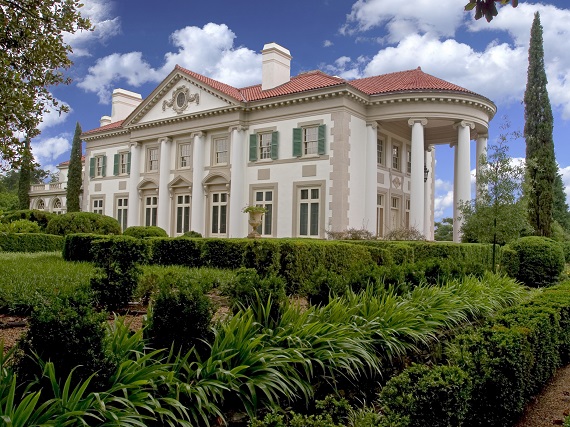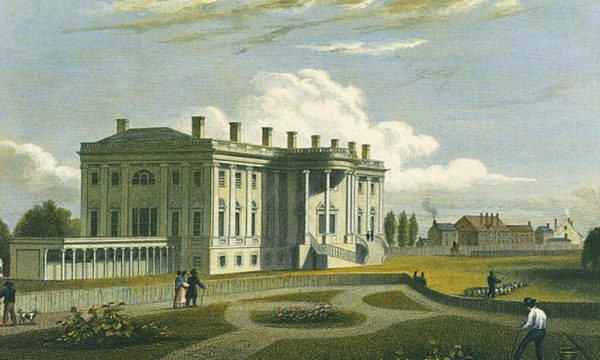The Callaway Gardens visitors center in Pine Mountain, Georgia shows a film explaining the history of the Callaway family, their conservation efforts, and the Gardens itself. At one point, the film directly refutes the conservation ethos made popular by Gifford Pinchot and Teddy Roosevelt, namely that private individuals ruin land while governments protect and preserve it. The Gardens are hailed as the balance between man and nature. This is sacrilege in the conservation community, but the Callaway story challenges conventional wisdom and more importantly exemplifies the Southern Jeffersonian tradition.
The Callaway family traces its American lineage to 17th century Maryland. John Callaway moved his large family from Maryland to North Carolina in the late 1700s and then to Wilkes County, Georgia where he died in 1821. John Callaway’s son, Enoch, became a Baptist minister in 1823 and was a founding member of the Southern Baptist Convention in 1845. The Callaway’s large estate in Wilkes County served as the anchor for the family, and agriculture and the agrarian life, along with devout Christianity, became part of their blood. Enoch Callaway’s son, Abner Reeves Callaway, also served as a man of the cloth at various churches in West Georgia, but after the War for Southern Independence he moved his family to LaGrange in Troup County, Georgia where he became a recognized leader of the community in both spiritual and secular pursuits.
Abner Callaway had an intense devotion to God and the land. He excelled at farming, was a keen scholar, and eventually accepted a position as Professor of Natural Science and Belle Letters at Southern Female College in LaGrange, now LaGrange College. Most of the buildings at LaGrange College carry the Callaway name today. Abner Callaway personified Jeffersonianism. He loved the land, family, community, and education. His son Fuller Callaway took the family in a different direction but still maintained Southern ideas on industry, labor, and community.
Fuller Callaway believed that hard work, personal relationships, and thrift were the keys to success. He used to say that he and his wife lived on “cash street” while everyone else lived on “mortgage street.” To Fuller Callaway, living on mortgage street, even when he could afford it, seemed foolish. He farmed his own land, saved every penny, and in 1888, at the age of eighteen, took the $500 in his pocket and started a thrift store in LaGrange. Business took off for the young entrepreneur, but only because Callaway treated employees and customers alike: honestly and fairly. In just a few years, Callaway opened a chain of thrift stores around West Georgia and began looking for other opportunities. In 1895, he led an investment team in opening Dixie Mills in LaGrange. Callaway wanted to make money, but he also had the community in mind:
It was like the measles in the South in those days. Every town wanted to build a cotton mill. We got it in LaGrange. We did not have much of anything, but we got up a cotton mill; and auctioned off the directorships. Anybody that would take $5,000 worth of stock, we would make a director; and if a widow with a son had $2,000, we would make the son a bookkeeper. We organized our little mill, and got our home people there to work in it, and we worked it along rather human lines. Everybody was proud of it and carried everything he had in it. A good many of the laborers took stock in it. We had a great many poor white people with the highest type of morality and religion. They could not produce cotton at five cents a pound against the negro; and these men began to move to town as cotton mill operatives. Their position in the country had been so poor, on account of the low price of their product, that it elevated them even to bring them to town to work in a cotton mill, which in itself was a poorly-paid occupation.
Working along “human lines” with people of the “highest type of morality and religion” became staples of the Callaway tradition. He started a bank to help poor cotton farmers–those ignored and chastised following the War–gain capital. One mill competitor said that Fuller Callaway was a “white oak, and you can’t get to the end of his taproots.” He called the people of his community “the finest people on earth–pure Americans.” He hired people through family connections and made family and community a priority.
The foreign management team (i.e Northerners) ran Dixie Mill into the ground in the first two years, so other investors began to pressure Callaway to take over. He did, and within short order the mill turned a profit. He sold his stake in the mill but returned to the mill industry within two years, this time in 1901 as the secretary-treasurer of Unity Mills.
For the next twenty years, Fuller Callaway would expand his mill holdings and revolutionize the mill industry in the South. He had a simple motto: “If you are working with cows, you have to think like cow. If you are working with men, you have to think like them. And you must never expect them to do anything that isn’t human.” Fuller Callaway made working for Unity Mills comfortable for the workers and their families, providing houses, schools, churches, parks, and gardens. His labor practices could be considered paternalistic, an old Southern tradition, and he took pride in the well being and intellectual development of his workers. He often said, “I make American citizens and run cotton mills to pay the expenses.” But his Americanism was distinctively Southern. He considered gardens to be essential. Once a woman had a stake in the community (and by default her husband as well), they would never want to leave. A garden made that possible. Working with the land and producing something soothed the soul. Though a prosperous industrialist, Fuller Callaway was still an agrarian at heart. He eventually purchased an estate in LaGrange named Hills and Dales where he built a large Roman inspired villa complete with a substantial Italianate garden. The land softened his industrial pursuits. Hills and Dales is still the Monticello of LaGrange.
Fuller Callway’s son, Cason Callaway, carried the Callaway tradition to a wider population. He presided over the family business and saved the family from financial ruin during the Great Depression. Fuller Callaway often said that if everyone on a sinking boat went to one side, you should go to the other. If you can swim, you have a chance. The same applied to business. No one should go into business with the intent of doing what everyone else was doing. A moderate businessman was a poor businessman. In the 1920s, Cason Callaway took this advice and changed course. He could see that the economy was artificially inflated, and he advised his sons to choose one business and sell off their interests in the others. They chose textiles. Cason Callaway and his sons established Callaway Mills Corporation and eventually developed partnerships with several large corporations, including General Motors. They never closed a plant during the Great Depression and their employees continued to work through tough economic times. Just as his father before him, Cason Callaway excelled as a businessman, but the land kept calling.
Cason Callaway resigned from Callaway Mills in 1937. He moved his family to their rural retreat, Blue Springs, complete with a rustic cabin that the family enjoyed for its charm and serenity. In 1944, Callaway established a 40,000 acre experimental farm at his Blue Springs estate (now the home of Callaway Blue Spring Water fed from the natural spring at the base of Pine Mountain. It is the the best bottled water I have tasted). He intended to help Southern farmers reform their agricultural practices, many of which had led to the exhaustion of the soil. His “One Hundred Georgia Better Farms” program lasted until 1950.
After he suffered a heart attack in 1948 and a flood buried the farm in mud in 1949, Cason Callaway turned his attention to some worn out cotton land near Pine Mountain. He wanted to build a garden for the public to enjoy, a rural retreat that symbolized Southern horticulture. The end result was Callaway Gardens, a sprawling nature reserve complete with public gardens, lakes, hiking trails, boating, golf, and fishing. Opened in 1952, the Gardens had 1 million visitors by 1956. Cason Callaway had returned the family to its roots and preserved the Southern agrarian tradition for future generations. Mills had turned to azaleas, butterflies, and hardwood forests. Fuller Calaway made American citizens from mills; Cason Callaway made plants and trees and in the process saved the Southern American soul.
In 1916, Fuller Callaway told to a reporter that, “We were busted down here for a time by the aftermath of the Civil War and the panic of 1873. The people were out in the hills getting a bare living out of the ground. But they are getting up again. They will get anything they want in time….The best foundation for a business enterprise is just to set down in your mind one phrase: Everything happens that couldn’t. When you learn that, you’ll believe.” Such optimism epitomized the Callaway family. It should make an impression on modern Southerners as well. Perhaps that spirit could help save the Jeffersonian tradition. We often think it is lost, but “Everything happens that couldn’t.”






